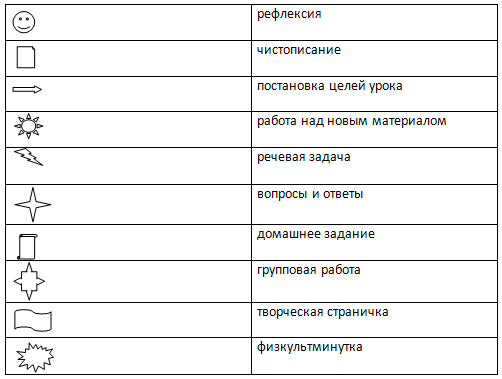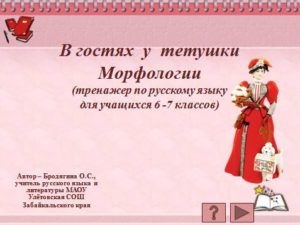primary-schooler
IBOU "Zimenkovo SOSH"
Contents
Topic: Main and secondary members of the proposal.
Vegetables, berries and fruits are the most vitamin foods.
acquaint children with secondary members of the proposal by observing the proposals, as well as on the basis of analysis of proposals;
- continue work on the formation of spelling skills, develop the speech of children, their vocabulary;
- on the basis of work with speech material to give an idea of the most useful and necessary products for a person;
- continue to familiarize students with a variety of fruits, berries, vegetables, their useful properties, vitamins (based on interdisciplinary connections: the Russian language and the surrounding world).
Equipment:
- a set of cards with words (set number 1, set number 2);
- 4 cups with liquids of different colors;
- symbols of the stages of the lesson and types of work (on tablets).

Class progress
I. Reflection.
Teacher. (I invite the children to sit on the mat.).
- Today we start working on this magical mat. Why magic?
Amazing transformations are taking place on this mat. Close your eyes and imagine that you have turned into a vegetable, berry or fruit.
- Open your eyes. Describe your fruit (vegetable, berry) without naming it. Tell me why you chose this fruit.
You describe, and the guys guess who you have become.
(For example: I am red, round, juicy, thick, sweet, useful.)(watermelon)
- I chose watermelon because it is very useful: it has a lot of iron.
The teacher asks for two or three more students.
- Thanks, guys. For the next lesson, pick up the puzzles to what you turned into.
- What helped you guess who the students were? ?Signs of objects used in speech.
- Today in class, studying a new topic of the Russian language, we will talk about fruits, vegetables, berries.
I suggest you go to the desks and get acquainted with the plan of our lesson.
Purification.
Finger gymnastics.
- Kneading the finger pads.
- The Skalka exercise.
- What do we learn from writing? ?We learn to write beautifully, neatly, quickly, correctly combining letters.
- Look at the board:
ate lo la
. . . . butcher's . . . block to . . .
- What task do I have to do?(Putting in the missing letters).
- What's the word "extra"? Why?
Ilya. Setting lesson goals. Working on new material.
The blackboard reads:
acidic
- What can you say about this recording? ?These are adjectives. They relate to products).
- Give an example for each column. Write in each column as many names as possible of vegetables, fruits and berries that fit these adjectives.
|
The gifts of nature |
||
|
round |
sweet |
acidic |
|
apple |
banana |
lemon |
I suggest taking three words from the table and making simple sentences with them.
Sample: Watermelon grows.
The apples are ripe.
The cherry fell.
- Discuss membership proposals. Which members of the proposal did you single out?(The subject and the predicate are the main members of the sentence.)
- Add adjective names to these sentences. (Sweet watermelon grows)- What did you notice?
- To which part of the sentence do the adjectives belong?(To the subject. They sort of define it.
- Well done! We made a discovery today. It is a secondary member of the sentence which distributes the subject and is calleddefinition.
- Read about it in the textbook.
- So, what are we working on in class? ?Over the secondary member of the sentence - definition.
Emphasize in your sentences the definitions of the wavy line.
ІV. Group work.
Now you will be divided into groups of 4 people. Remember the rules of working in groups.
Each group receives a set of cards on which the names of products are written.
A mission.Create a story using words from cards.
|
Set 1 |
Set 2. |
|
cherry |
cake |
At the end of the work, each group reads its story.
- By what principle do you think the product sets are divided into two groups? Are vegetables, fruits and berries useful? What about the second set? ?In vegetables, fruits and berries a lot of vitamins. So they're very useful. But sweet to eat a lot harmful, as it clogs the intestines and spoiled teeth.
V. Physical minute.
"Where are the many vitamins?"
- You'll stand in a circle. I throw the ball to any student, naming the product. If this product has a lot of vitamins (this is a vegetable, fruit or berry), then the student catches the ball, and the rest clap their hands. If the product does not contain vitamins, then the ball is thrown away, and you stomp your feet.
You. Creative page.
- Let’s play the game “I’ll start and you’ll continue.”
It is familiar to you, only we will use fruits, vegetables, berries in the game.
Went down the forest path
Grandma with a basket...
(And in that basket of mushrooms,
Berries and fruits.
The rabbits followed her.
And they carried carrots.
And a squirrel for pleasure.
She was carrying nuts...)
- Well done!
You. Speech task "Describe the product".
The teacher holds a tray in his hands; on the tray 4 glasses with liquid: in one glass, an orange-colored liquid; in the second - yellow, in the third - crimson, in the fourth - colorless.
- Guys, look at my tray. What question could you ask me? ?What's in your glasses? Why is water colorful?
- You need to determine: what vegetables and fruits can give juice of this color? ?Orange - orange, carrots; yellow - peach, cherry; crimson - raspberries, cherries, beets; colorless - cucumber, birch, etc.)
VIII. Reflection.
- Today we talked a lot about fruits, vegetables, berries.
- What topic of the Russian language did we talk about? ?On secondary members of the proposal.
- At the end of the lesson, I want you to draw any vegetable, fruit, berry in your notebook.
- What did you draw and why exactly this?
ix. Homework.(choice):
1) Make a festive fruit menu.
2) Advertise a useful product using as many adjectives as possible.
(3) Write "delicious" stories.
{module Google_kvadrat}
Lesson summary with illustrations in .doc format



